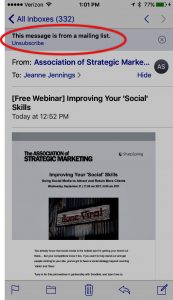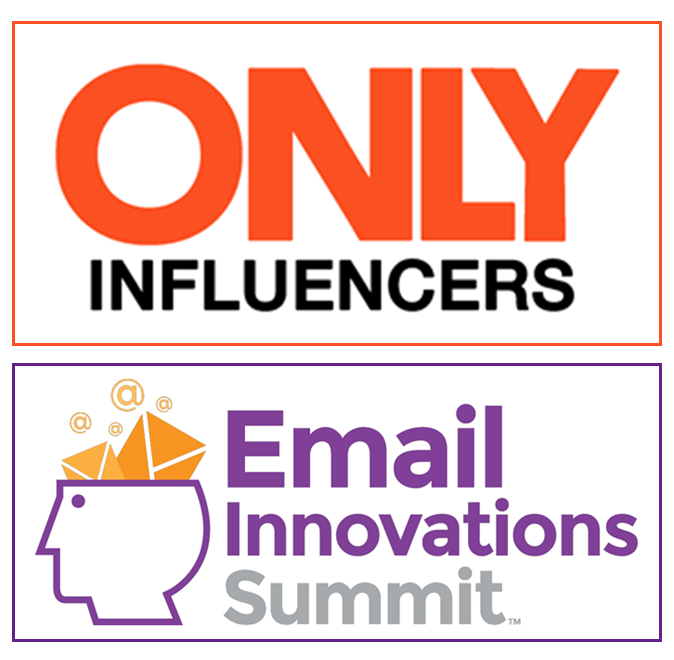Note: Happy Throwback Thursday! I downloaded iOS10 yesterday, partly to get a first-hand look at the new prominent unsubscribe link in the email app (image below). I was reminded of this article that I wrote for ClickZ two years ago, when Gmail added a prominent unsubscribe to its interface. At that time marketers were fearful that people would remove themselves from lists in droves — but that didn’t happen. I think we’ll see the same here. Read on to get more on my take — and take a look back at some innovative unsubscribe links from a client case study. Enjoy!
The email marketing world was abuzz recently with the news of Gmail adding an unsubscribe link next to the “from” address in emails that are viewed in its client (see below). The “company line” is that this is good for email marketers – that people who might otherwise click the “Report Spam” button will instead use this link to unsubscribe, thereby not causing a smudge on the email sender’s reputation.
Figure 1: Unsubscribe Link Added by Gmail

And this is a good thing. But some marketers have expressed concerns about use of this new unsubscribe mechanism by less disgruntled readers – people who would never consider reporting the email as spam, but who might, due to the prominence of this new unsubscribe mechanism, go ahead and remove themselves from the list anyway.
The Gmail announcement comes at an interesting time for me personally. I’ve gone from someone who was dramatically opposed to prominent unsubscribe links in email messages to being a proponent of those same links, in most cases.
So I thought I would share a client case study which was instrumental in my change of heart, as well as some innovative work that my agency, Alchemy Worx, is doing for clients around prominent unsubscribe mechanisms (much more prominent than the ones Gmail is adding!). And maybe, just maybe, after reading this article you’ll come to love prominent unsubscribe mechanisms as much as I do!
Back in September 2010 I was on a panel at ExactTarget’s Connections Conference; the topic of prominent unsubscribe buttons came up. One of the other panelists supported it – I was firmly against it. It made for good theater; we moved from the usual dating analogies into “morning after” analogies – with me suggesting that a prominent unsubscribe mechanism was akin to your new friend waking up to find you holding the front door open for them.
Fast-forward three-and-a-half years. My sparring partner has changed companies; his former employer no longer includes a prominent unsubscribe mechanism at the top of their emails – and here I am advocating the practice.
Back then the prominent unsubscribe struck me as a show of insecurity; using it suggested that you weren’t firmly convinced that the content you were providing was valuable to readers. If the sender doubts the value of their email messages, why should recipients disagree?
But today my thinking has changed. I see a prominent unsubscribe mechanism as a sign of confidence. In this day of segmentation, targeting, and the importance of relevance, you don’t necessarily want to be all things to all people. So make no apologies and make it easy for people to remove themselves if your email has become “bacn” to them.
David Carpio, email marketing manager at Zeeto Media and an Alchemy Worx client, sums it up very well: “In today’s world, where engagement metrics play a large role in whether your email messages reach the inbox or not, it’s important to be transparent and not hide behind the deceptive practices of the past that cause legitimate marketers to be lumped into the same group as spammers.”
Carpio and his team at Zeeto began testing prominent unsubscribe mechanisms last summer, in their welcome message. Zeeto’s entire list is made up of opt-in subscribers, but some are more interested in a long-term email relationship than others. So for those just in it for the immediate sign-up incentive, they offer them a way off right away.
They waded into the prominent unsubscribe arena with a simple button. Once that proved effective, we helped them design mechanisms for their other email messages (daily newsletters and such) which were more in line with their brand: playful, fun, and very kitten-friendly. We’re in the process of testing them now, but some examples follow.
Figure 2: Unsubscribe Links We Developed for and Are Testing With Client Zeeto Media

The copy is meant to be playful – it provides a way to unsubscribe but attempts to get the reader to think twice before they do. The buttons, when we use them, are bullet-proof, meaning that they appear as buttons even if images are blocked. Unfortunately, the kitten image won’t appear if images are blocked, but the copy works almost as well without it.
And note: The new Gmail unsubscribe mechanism is actually much less prominent than what we’ve designed for Zeeto.
One more note: Some email marketers wonder whether Google has overstepped its bounds; they’re asking if the practice of adding an unsubscribe link like this is legal. I’ll leave that to the lawyers. My focus is on helping my clients make their email marketing more effective and more profitable.
Until next time,
Jeanne







